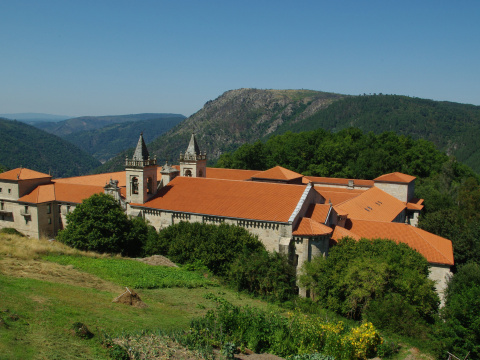

Church of Santo Estevo de Ribas de Miño
The first sources which are known about this former monastery refer to an inventory of the bishopric of Lugo of the 12th century, being a donation by Mrs Urraca Fernández.
The most outstanding of the current building is its adaptation to the land. It was necessary to reduce the slope, as well as to build a crypt to hold the base of the temple. It was a new solution presented by Master Matthew in Galicia with the crypt of the Cathedral of Santiago. No doubt there are many elements that lead us to the art of Matthew in this church.
Inside, it is structured in a single wide nave, with four sections with their windows and wooden ceiling and slightly pointed diaphragm arches loading columns. Surely it was initially considered a cover of stone which was not carried out in the end. The apse also reflects influences from the Cathedral of Ourense; with a few curious rose windows with geometric tracery that bring more light to the interior. The vault is supported on corbels. The three semicircular niches also refer to Ourense and are in Pesqueiras too. Slender buttresses reinforce externally the nave. It has elegance and strength in its proportions. The corbels are not decorated. The decoration is reserved for windows and doors, especially the front door to the valley, as well as the south gate.
The capitals are enriched with vegetable motifs, pearled shafts and trepanning points from Portomarín which are also in the nearby church of Pesqueiras. As in Portomarín, two indoor spiral stairs allow us to ascend to the corridor in front of the large rose window of the main facade. It is considered as one of the largest in Galicia.
If something should be highlighted is its main facade by Matthew. The Pórtico de la Gloria is undoubtedly a reference and model, not only in forms but also in solutions. On the lower crypt is the facade structured in three openings which do not conform to the interior of the nave layout. A roof with corbels which support semicircular arches divide the facade into two, separating the large rose window with circles and long pentagons.
Archivolts, capitals, shafts, jambs and quoins lead us back to Portomarín. It highlights the choice of marble for the shafts of the columns and noble elements as opposed to granite from the rest of the building.
In the outer archivolt, at the three openings "grapes" or "pineapples" are represented, according to various theories. In the central opening there are plenty of archivolts decorated with vegetable motifs that may refer to forms of the flora in the area. But it highlights the inner archivolt with decoration of figures following the model of the Pórtico de la Gloria, evoking the heavenly orchestra since some carry musical instruments. One of them carries a Sun and another one a moon as a reference to the world.
At the same time, it deserves special mention the Epiphany kept inside nowadays. It comes from the recovery of several pieces found on the occasion of recent restorations. On the one hand, there are the Magi, who had been reused as flooring of the church. And the figure seated of the Virgin found in the atrium in the decade of the 1940s.
The Virgin is holding the child in her lap while holding a sort of mallet topped in an artichoke in her right hand. He turns to receive the gift offered by the first of the Magi, who kneel down takes his hand to his head to remove the crown as a sign of submission and respect. The other two standing wait their turn and it is incredible the similarity that show with the Magi on the cover of the Corticela, in the Cathedral of Santiago. The image of the Virgin keeps traces of polychromy that in the case of the Magi has been lost.
We can also admire a beautiful and original Romanesque baptismal font with very peculiar geometric decorations.
Outside, a curious bell tower on a rock stands out, though it is without a doubt the result of subsequent reforms.
You can take a 360º virtual tour clicking here.
Don't miss!
In addition to this monastery, there are other equally iconic Romanesque sites in Ribeira Sacra. Two good examples are the Church of San Paio de Diomondi and the Church of San Vitoiro de Ribas de Miño, and we recommend both of these for a visit.
Santo Estevo de Ribas de Miño Church
Information and contact

Santo Estevo de Ribas de Miño
O Saviñao
27594 Lugo

 Directions
Directions 


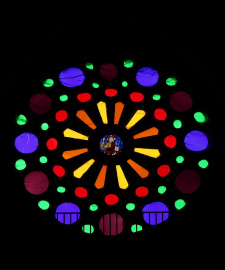
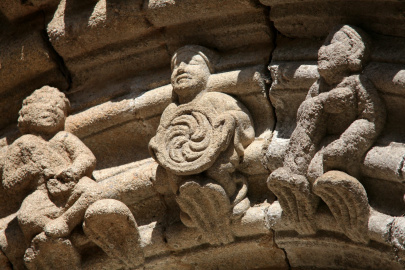
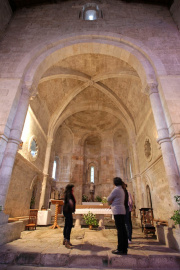
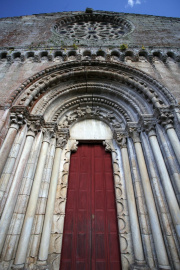

 What would you improve?
What would you improve? 